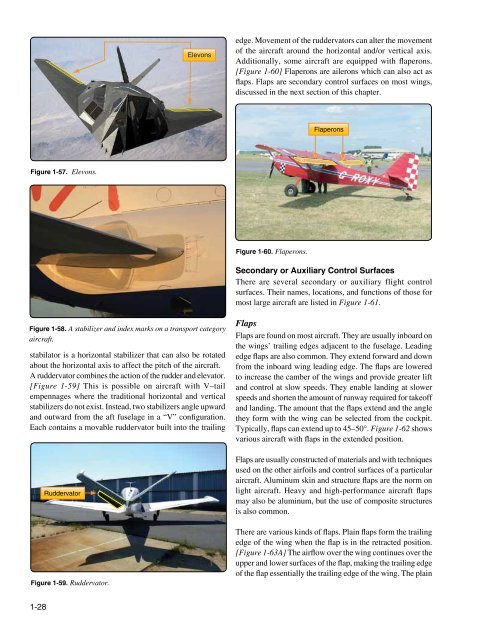You also want an ePaper? Increase the reach of your titles
YUMPU automatically turns print PDFs into web optimized ePapers that Google loves.
Elevons<br />
edge. Movement of the ruddervators can alter the movement<br />
of the aircraft around the horizontal and/or vertical axis.<br />
Additionally, some aircraft are equipped with flaperons.<br />
[Figure 1-60] Flaperons are ailerons which can also act as<br />
flaps. Flaps are secondary control surfaces on most wings,<br />
discussed in the next section of this chapter.<br />
Flaperons<br />
Figure 1-57. Elevons.<br />
Figure 1-60. Flaperons.<br />
Secondary or Auxiliary Control Surfaces<br />
There are several secondary or auxiliary flight control<br />
surfaces. Their names, locations, and functions of those for<br />
most large aircraft are listed in Figure 1-61.<br />
Figure 1-58. A stabilizer and index marks on a transport category<br />
aircraft.<br />
stabilator is a horizontal stabilizer that can also be rotated<br />
about the horizontal axis to affect the pitch of the aircraft.<br />
A ruddervator combines the action of the rudder and elevator.<br />
[Figure 1-59] This is possible on aircraft with V–tail<br />
empennages where the traditional horizontal and vertical<br />
stabilizers do not exist. Instead, two stabilizers angle upward<br />
and outward from the aft fuselage in a “V” configuration.<br />
Each contains a movable ruddervator built into the trailing<br />
Ruddervator<br />
Figure 1-59. Ruddervator.<br />
Flaps<br />
Flaps are found on most aircraft. They are usually inboard on<br />
the wings’ trailing edges adjacent to the fuselage. Leading<br />
edge flaps are also common. They extend forward and down<br />
from the inboard wing leading edge. The flaps are lowered<br />
to increase the camber of the wings and provide greater lift<br />
and control at slow speeds. They enable landing at slower<br />
speeds and shorten the amount of runway required for takeoff<br />
and landing. The amount that the flaps extend and the angle<br />
they form with the wing can be selected from the cockpit.<br />
Typically, flaps can extend up to 45–50°. Figure 1-62 shows<br />
various aircraft with flaps in the extended position.<br />
Flaps are usually constructed of materials and with techniques<br />
used on the other airfoils and control surfaces of a particular<br />
aircraft. Aluminum skin and structure flaps are the norm on<br />
light aircraft. Heavy and high-performance aircraft flaps<br />
may also be aluminum, but the use of composite structures<br />
is also common.<br />
There are various kinds of flaps. Plain flaps form the trailing<br />
edge of the wing when the flap is in the retracted position.<br />
[Figure 1-63A] The airflow over the wing continues over the<br />
upper and lower surfaces of the flap, making the trailing edge<br />
of the flap essentially the trailing edge of the wing. The plain<br />
1-28



